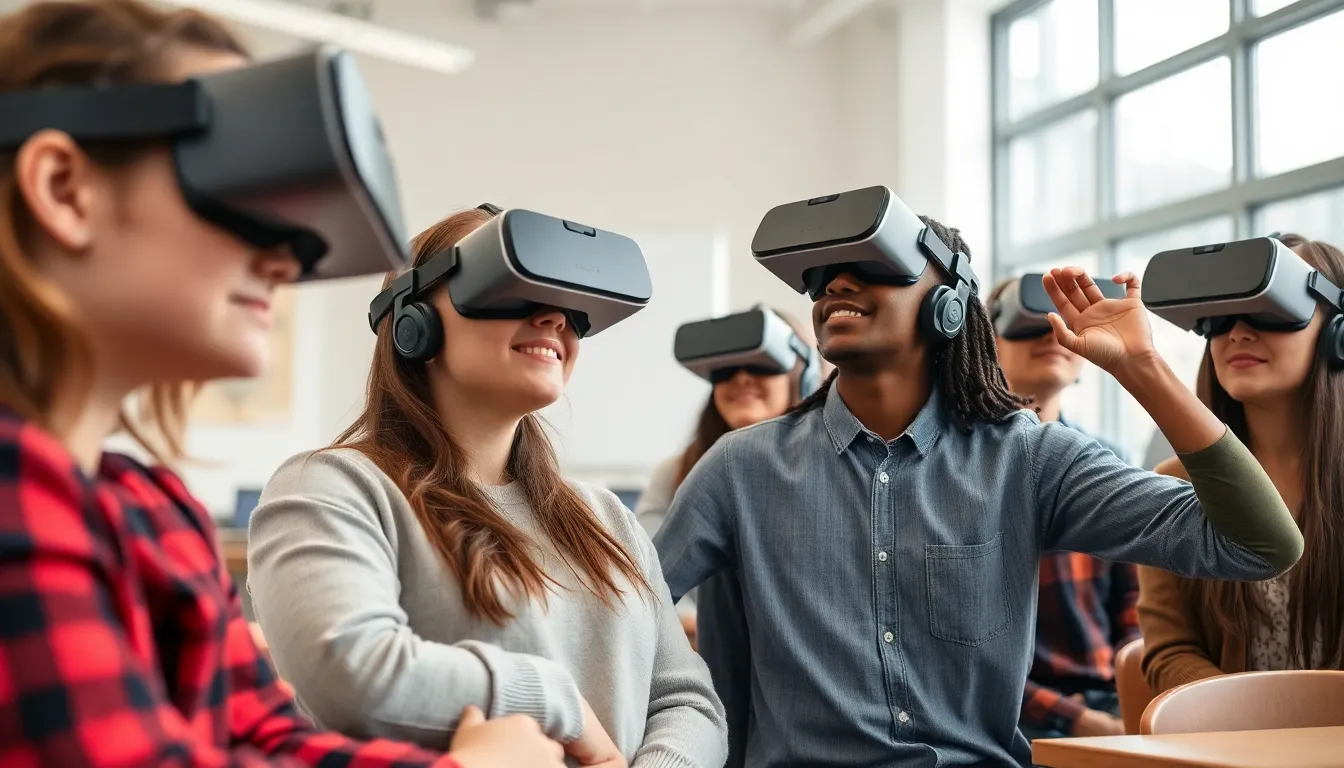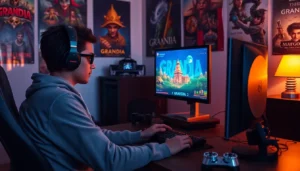Virtual reality (VR) is revolutionizing the way people learn and interact with technology. From immersive training programs to engaging educational experiences, VR tutorials are paving the way for innovative teaching methods that captivate learners like never before. As this technology continues to evolve, it’s essential to understand how these tutorials can enhance skills and knowledge across various fields.
Incorporating VR into learning environments not only makes education more interactive but also caters to diverse learning styles. Whether someone is a visual learner or prefers hands-on experiences, VR offers tailored solutions that can boost retention and comprehension. As the demand for effective and engaging educational tools grows, exploring the world of VR tutorials becomes increasingly important for educators and learners alike.
Table of Contents
ToggleOverview of VR Tutorials
VR tutorials utilize immersive technology to enhance learning experiences across various fields. These tutorials promote active engagement through interactive environments that cater to visual, auditory, and kinesthetic learners. By simulating real-world scenarios, individuals practice skills in a controlled space, reducing the risks associated with hands-on learning.
Examples of VR tutorials include medical simulations, engineering design programs, and language learning environments. Specifically, medical students use VR to practice surgical techniques, while engineers visualize complex structures in 3D. Language learners engage in immersive conversations that boost retention and comprehension.
Integrating VR tutorials into educational curriculums enriches traditional teaching methods and promotes collaborative learning. Educators can create customized lessons that address specific learning objectives, ensuring a tailored approach for each student. This adaptability makes VR tutorials a valuable resource for diverse educational settings.
As advancements in technology continue, VR tutorials will expand further, offering even more specialized and impactful learning experiences. Embracing these innovations is essential for educators and learners aiming to stay ahead in an evolving educational landscape.
Benefits of VR Tutorials

VR tutorials offer several key benefits that enhance the educational experience, making learning more effective and enjoyable. These advantages include enhanced engagement and interactive learning opportunities.
Enhanced Engagement
Enhanced engagement results from immersive experiences provided by VR tutorials. Learners can fully immerse themselves in the content, which captures attention and promotes motivation. Studies indicate that students participating in VR experiences report higher levels of interest compared to traditional learning methods. With the ability to step into realistic environments, learners find complex concepts easier to grasp, promoting deeper understanding.
Interactive Learning
Interactive learning becomes a core feature of VR tutorials. Users participate in hands-on activities within simulated environments, reinforcing theoretical knowledge through practical application. VR allows learners to experiment and take risks in a safe space, facilitating skill development without real-world consequences. Additionally, real-time feedback during these immersive experiences encourages immediate adjustments, enhancing learning outcomes. Through scenarios like virtual labs or historical re-enactments, learners develop critical thinking and problem-solving skills effectively.
Types of VR Tutorials
Various types of VR tutorials exist, catering to different fields and learning objectives. Two prominent categories are educational VR tutorials and industry-specific VR tutorials.
Educational VR Tutorials
Educational VR tutorials focus on enhancing classroom learning through immersive experiences. These tutorials cover subjects such as science, mathematics, history, and language arts. They create interactive simulations, allowing students to explore concepts visually and kinesthetically.
Students engage in virtual experiments in science classes, explore historical events in immersive environments, and practice language skills in realistic scenarios. For example, medical students can perform virtual surgeries, while history students can witness ancient civilizations firsthand. Such tutorials improve understanding and retention by allowing learners to apply theoretical knowledge in simulated situations.
Industry-Specific VR Tutorials
Industry-specific VR tutorials target professional training across various sectors, enhancing skill acquisition and competence. Industries such as healthcare, engineering, aviation, and manufacturing benefit from these tutorials. They provide real-world scenarios that simulate high-stakes environments where trainees can practice essential skills.
Healthcare professionals use VR to refine their techniques in surgery and patient interaction. Engineers visualize complex structures and test prototypes in virtual settings. Pilots simulate flight scenarios, enhancing their decision-making skills under pressure. By focusing on industry-specific tasks, these tutorials ensure trainees gain relevant experience while minimizing risks associated with real-world training.
Best Practices for Creating VR Tutorials
Creating effective VR tutorials requires attention to specific design and technical elements. Adopting best practices enhances user engagement and ensures a seamless learning experience.
User-Centered Design
User-centered design focuses on understanding the needs and preferences of learners. Prioritize the following aspects:
- Target Audience: Identify the specific learners’ characteristics, such as age, background, and skill level, to inform content development.
- Intuitive Navigation: Ensure users can navigate the VR environment easily. Use familiar controls and clear visual indicators for a smooth experience.
- Engaging Content: Develop interactive elements that capture interest. Incorporate quizzes, challenges, or decision-making scenarios to motivate engagement.
- Feedback Mechanisms: Provide immediate feedback to reinforce learning. Utilize prompts or visual cues to guide users toward correct actions or concepts.
- Accessibility: Ensure all learners can access content. Consider including options for different sensory abilities, such as subtitles or audio descriptions.
Technical Considerations
Technical aspects significantly impact the effectiveness of VR tutorials. Address the following considerations:
- Platform Compatibility: Choose VR platforms that cater to the intended user base. Consider devices like Oculus Quest or HTC Vive for broader accessibility.
- Performance Optimization: Optimize graphics and simulations for smooth performance. Minimize lag time and ensure quick loading to enhance user experience.
- Quality of Visuals: Use high-quality graphics to create immersive environments. Realistic visuals enhance learner engagement and retention of information.
- Testing and Iteration: Conduct thorough testing before launch. Collect user feedback and iterate on design elements to address any issues or concerns.
- User Support: Provide resources for users to troubleshoot potential problems. Include FAQs or support forums to assist those encountering difficulties.
Implementing these best practices leads to the creation of effective VR tutorials that foster a productive learning environment.
The rise of VR tutorials marks a significant shift in educational practices. By leveraging immersive technology, they offer unique opportunities for learners to engage actively and apply knowledge in realistic settings. This innovative approach not only caters to diverse learning styles but also enhances retention and skill development.
As educators and learners embrace these advancements, the potential for VR tutorials to transform traditional education becomes increasingly evident. The focus on user-centered design and effective technical execution ensures that these tools can meet the needs of various audiences. Adopting VR tutorials is a step toward a more interactive and effective learning experience, paving the way for future advancements in education.


